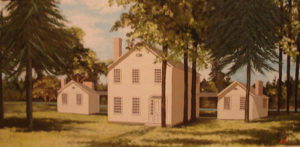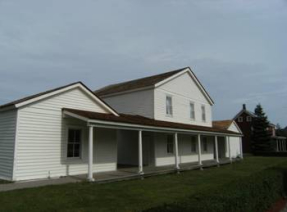As the Indian Agent for the northwest since 1822, the War Department had promised Henry Rowe Schoolcraft an office and house. Funding for the house was problematic until 1828 when Schoolcraft secured permission and an allotment of the funds to build the Agency House. In 1828, Obed Wait, who had previously designed Michigan’s territorial capital of Detroit, directed construction of the Indian Agency building. Wait adopted formal federal-style architecture, considered appropriate for the government buildings at that time, to produce a central two story structure flanked by two symmetrically placed wings. Although designed by Wait, Schoolcraft specified many of the features that were built into the house.
 Elmwood, situated on an elevated southern bank of the St. Mary’s River, would serve as the Schoolcraft home and as the Indian Agency. The home was built in a grove of elms and other mature trees about a mile east of Fort Brady and east of the Johnston family home. The entire structure was nearly 100 feet long, with a veranda running the full length. It had 15 rooms – three stories and a basement. The eastside dependency was the kitchen and the west side was used as Schoolcraft’s Indian Agency office.
Elmwood, situated on an elevated southern bank of the St. Mary’s River, would serve as the Schoolcraft home and as the Indian Agency. The home was built in a grove of elms and other mature trees about a mile east of Fort Brady and east of the Johnston family home. The entire structure was nearly 100 feet long, with a veranda running the full length. It had 15 rooms – three stories and a basement. The eastside dependency was the kitchen and the west side was used as Schoolcraft’s Indian Agency office.
Elmwood was the first frame building erected in Sault Ste. Marie, Michigan. The front door faced north towards the river. The house and surrounding area had the feel of a manor – elegant, imposing, surrounded by fields, barns, and outbuildings, formal gardens and a kitchen garden.
The inside of the home was as elegant as the outside, with the high ceilinged, spacious rooms lined with cabinets for holding Schoolcraft’s books, mineral specimens, and Indian artifacts. The Schoolcrafts moved into the house in the fall of 1827 and resided there with their two children until 1833. The years spent at Elmwood were some of the happiest years for the Schoolcrafts.
In 1853, the government leased Elmwood to Charles T. Harvey, who supervised the construction of the first Soo Locks while living in the house. Sault Ste. Marie merchant and businessman Peter Barbeau purchased the building in 1874 when the government sold it. Around the 1880s, substantial Queen Anne-style alterations were done to the building, diminishing the “classical elegance” of the original design. Around 1900, the building, along with a swath of the surrounding shoreline, was sold to the Michigan Lake Superior Power Company. It was used as an office building, than lay vacant for decades while owned by Union Carbide. It was used in the 1950s and 1960s to display the collection of the Chippewa County Historical Society. It was designated a Michigan State Historic Site in 1956 and listed on the National Register of Historic Places in 1974.
 In 1979, Elmwood was relocated at 435 East Water Street, next to the John Johnston’s house, when Edison Sault Electric constructed their enclosed distribution center. A stone adorned with a descriptive plaque has been placed in the exact location where the house stood at 705 East Portage Avenue. The Schoolcraft west dependency is now used as a museum with artifacts depicting the Indian Agency. During the summer months, the four houses considered as the Historic Water Street Block are open to the general public. Docents associated with the Chippewa County Historical Society welcome visitors to tour the historical homes. The eastside dependency is the base for the children’s Summer History Camp, sponsored by the society. Activities and programs are offered during a one-week period in early June.
In 1979, Elmwood was relocated at 435 East Water Street, next to the John Johnston’s house, when Edison Sault Electric constructed their enclosed distribution center. A stone adorned with a descriptive plaque has been placed in the exact location where the house stood at 705 East Portage Avenue. The Schoolcraft west dependency is now used as a museum with artifacts depicting the Indian Agency. During the summer months, the four houses considered as the Historic Water Street Block are open to the general public. Docents associated with the Chippewa County Historical Society welcome visitors to tour the historical homes. The eastside dependency is the base for the children’s Summer History Camp, sponsored by the society. Activities and programs are offered during a one-week period in early June.
The historic homes are owned by the City of Sault Ste. Marie. Major restoration work has already been completed on a number of them, including the inside of Elmwood. There is still more to be done, before the site will be completely restored. Once the staged projects will be finished, you will be able to tour the residence and learn more about our history.
